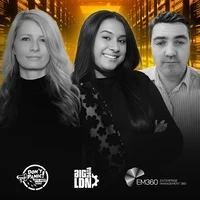
The Power of Using Hyperconvergence
As in today's fast-moving digital world, agility and efficiency are key. Hyperconvergence infrastructure combines computing, storage, networking, and high-quality software into a single system. This integrated technology promises rather quick deployment and easier management for the age of the cloud. Furthermore, Transparency Market Research predicts that by 2025, the global HCI (Hyper-converged infrastructure) market will be worth 31 billion. It seems that using hyperconvergence is a key motive for companies in enterprise technology.
In a quest to deliver these new, enhanced infrastructures, many leading vendors have been funnelling their R&D budget into new converged solutions. Here are ten of the most impressive companies using hyperconvergence in the market today.
Cisco
One of the world’s best-known communication companies, Cisco entered the hyperconvergence market in 2016. Their initial product was “HyperFlex,” which launched on the Cisco UCS platform. HyperFlex was designed to enhance the first-gen hyper convergence with more efficient scaling, integrated networking and more.
Today, Cisco continues to drive R&D budgets into their hyper convergence strategy, to deliver an experience that’s number one in enterprise performance. HyperFlex extends the abilities of using hyperconvergence platforms from core, to multi-cloud and edge computing. With Cisco Intersight, Cisco users can now deploy hyper-converged infrastructure at the edge of their technology stack, at a global scale.
Overall, it seems that by using hyperconvergence, companies can prove themselves to be agile in the enterprise.
Hypergrid
Leading hyper-converged infrastructure organization, Gridstore purchased a container software company in 2016 and rebranded as Hypergrid. Today, the company offers a “hyperconvergence as a service” solution to businesses that need simple access to HCI.
When the company rebranded, it’s CEO Nairman Teymourian said that businesses were developing more solutions delivered over infrastructure-as-a-service for simplicity and flexibility. Teymourian claims that Hypergrid’s technology can claim everything you need for enterprise-grade platforms. What’s more, you get all that tech with a pay-as-you-go pricing structure.
HPE Simplivity
Designed by Hewlett Packard Enterprise, the Simplivity brand focuses on the desire to bring hyper convergence to the masses. HPE Simplivity aims to make hyper-converged infrastructure available to anyone with speedy performance, resiliency, and efficiency. Originally, HPE Simplivity entered the market for HCI in 2012 with the OmniCube product. The OmniCube builds on the OmniStack platform for data virtualization.
Today, Simplivity continues to offer advanced Hyperconverged solutions as a leader in the Gartner Magic Quadrant.
Nutanix
Nutanix is a business known for its state-of-the-art infrastructure solutions. During 2018, the company was named a leader in the 2018 Gartner Magic Quadrant for hyper-converged infrastructure. Despite growing competition from other players, Nutanix remains strong. The company launched its first hyper convergence product in 2011, with the message of “ban the SAN.” Now, Nutanix delivers everything you need for cloud architecture in a single package with the Nutanix Enterprise Cloud.
The cloud service is built on leading HCI tech and combines networking, virtualization, and computing in the same full-stack solution.
VMWare
A leader in the Gartner Magic Quadrant for Hyperconverged Infrastructure, VMWare is a brand synonymous with virtualization. The company expanded it’s HCI offering to ensure that the storage, compute, and network virtualization technologies available could also deliver a packaged HCI offering. Currently, VMWare claims to serve more than 4,000 customers with their virtualized storage area network product. It’s also one of the best-known vendors in the HCI market.
You can deploy VSAN along with a Cisco, Lenovo, HPE, Supermicro or Dell solution. Alternatively, you’ll also be able to buy a pre-packed EVO system with the components included all in one.
Huawei
6. Huawei The Huawei FusionCube Intel Server now comes with hyper-converged infrastructure baked into its core. There’s also database support for the SAP HANA, SQL Server, Oracle and more. If you need virtualization support, Huawei supports everything from FusionSphere to VMWare.
Though Huawei only managed to reach the “Challengers” section of the Gartner Magic Quadrant, it offers a powerful solution for HCI tech going forward. The company has an extensive ecosystem partner network, including both Red Hat and Microsoft.
NetApp
Storage Supplier NetApp unveiled their highly-coveted hyper convergence infrastructure product a little later than many of the options on this list. The NetApp HCI incorporates flash technology from the 2015 acquisition of Solidfire and allows businesses to access an advanced hybrid multi-cloud experience. If you’re looking for a frictionless way to transform your company’s architecture, NetApp could have the answer.
NetApp’s HCI solution is a little different from most first-gen HCI products because it comes with separate compute and storage nodes. The business believes this will give customers more granular scalability.
Dell EMC
The name “Dell” is well-known in IT circles around the world. With the help of EMC, Dell created its hyper-converged infrastructure solution. They claim that it offers the most straightforward and fastest way for companies to transform their organisation’s infrastructure. Whether you’re looking for a way to improve your path to the cloud with a new turnkey solution, or you need a new, modern data centre, Dell can help by using hyperconvergence.
The extent of the HCI portfolio from Dell EMC means you can choose the strategy that’s best-suited to your business goals.
Pivot3
Pivot3 is one of the early adopters of the HCI market. The company launched its first hyper-converged appliance for video surveillance apps in 2008, long before using hyperconvergence was popular. More recently, the organization revealed its Acuity HCI platform. This service combines QoS controls from the brand’s recent acquisition of NextGen with NVM flash tech to support a range of applications.
QoS controls set Pivot3 apart from many of the solutions in the HCI market, particularly as consumers continue to question the abilities of HCI in a multi-app environment.
Stratoscale
Stratoscale is still a relatively new member of the HCI market. The business only launched in 2013 however it benefits from a strong platform based on open source tech like ZFS for virtualized storage, and KVM for virtualization. According to market analysts like Forrester, the strength of Stratoscale lies in its abilities to support data and workload migration.
Additionally, Stratoscale offers a high-quality HCI solution with no vendor lock-in. The Hyperconvergence “Symphony” product also comes with Hypervisor included.













Comments ( 0 )